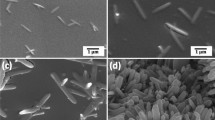Abstract
We describe the role of defects in the resistive switching behavior of metal–insulator–metal devices based on alternating Ta2O5 and TiO2 stacks. Ruthenium oxide (RuOx) and platinum (Pt) were used as bottom and top electrodes, respectively. Insulator stacks with thickness of 5 nm were fabricated by atomic layer deposition of alternating Ta2O5 and TiO2 thin films. Bipolar resistive switching behavior was obtained for Ta2O5-TiO2-Ta2O5 and TiO2-Ta2O5-TiO2 stacks, being mainly due to presence of oxygen vacancy defects. The best memristive response was obtained in the case of two TiO2 films embedding a monolayer of Ta2O5. Highly repeatable direct-current (DC)-voltage bipolar switching cycles were obtained. Small-signal admittance parameters also showed hysteretic behavior during a whole bipolar switching cycle. In the case of samples with three layers of similar thickness, when the transition from ON to OFF state (reset) occurred, the conductance abruptly increased and the susceptance decreased quickly for more negative voltages values. Such behavior was not observed when only one Ta2O5 monolayer was examined. These differences can be explained in terms of the charge transport mechanism occurring in the open conductive filaments.
Similar content being viewed by others
References
A. Beck, J.G. Bednorz, C. Gerber, C. Rossel, and D. Widmer, Appl. Phys. Lett. 77, 139 (2000).
R. Waser and M. Aono, Nat. Mater. 6, 833 (2007).
J.J. Yang, D.B. Strukov, and D.R. Stewart, Nat. Nanotechnol. 8, 13 (2013).
E. Gale, Semicond. Sci. Technol. 29, 104004 (2014).
H. Nili, S. Walia, S. Balendhran, D.B. Strukov, M. Bhaskaran, and S. Sriram, Adv. Funct. Mater. 24, 6741 (2014).
C. Chen, Y.C. Yang, F. Zeng, and F. Pan, Appl. Phys. Lett. 97, 083502 (2010).
Y.-T. Huang, C.-W. Huang, J.-Y. Chen, Y.-H. Ting, K.-C. Lu, Y.-L. Chueh, and W.-W. Wu, ACS Nano 8, 9457 (2014).
R. Waser, R. Bruchhaus, and S. Menzel, Nanoelectronics and Information Technology. Advanced electronic materials and novel devices, ed. R. Waser and P. Grumberg (Weinheim: Wiley-VCH, 2012), p. 683.
J. Yoon, H. Choi, D. Lee, J.B. Park, J. Lee, D.J. Seong, Y. Ju, M. Chang, S. Jung, and H. Hwang, IEEE Electron Device Lett. 30, 457 (2009).
M.H. Lin, M.C. Wu, C.Y. Huang, C.Y. Huang, C.H. Lin, and T.Y. Tseng, J. Phys. D Appl. Phys. 43, 295404 (2010).
C.H. Cheng, A. Chin, and F.S. Yeh, IEEE Electron Device Lett. 31, 1020 (2010).
M. Terai, Y. Sakotsubo, S. Kotsuji, and H. Hada, IEEE Electron Device Lett. 31, 204 (2010).
M.J. Kim, I.G. Baek, Y.H. Ha, S.J. Baik, J.H. Kim, D.J. Seong, S.J. Kim, Y.H. Kwon, C.R. Lim, H.K. Park, D. Gilmer, P. Kirsch, R. Jammy, Y.G. Shin, S. Choi, and C. Chung, IEDM Tech. Dig. 2010, p444 (2010).
Y.L. Song, Y. Liu, Y.L. Wang, X.P. Tian, L.M. Yang, and Y.Y. Lin, IEEE Electron Device Lett. 32, 1439 (2011).
T. Arroval, L. Aarik, R. Rammula, V. Kruusla, and J. Aarik, Thin Solid Films 600, 119 (2016).
B. Karunagaran, K. Kim, D. Mangalaraj, J. Yi, and S. Velumani, Sol. Energy Mater. Sol. Cells 88, 199 (2005).
O. Frank, M. Zukalova, B. Laskova, J. Kürti, J. Koltai, and L. Kavan, Phys. Chem. Chem. Phys. 14, 14567 (2012).
S. Bhaskar, P.S. Dobal, S.B. Majumder, and R.S. Katiyar, J. Appl. Phys. 89, 2987 (2001).
B. Hudec, A. Paskaleva, P. Jancovic, J. Dérer, J. Fedor, A. Rosová, E. Dobrocka, and K. Fröhlich, Thin Solid Films 563, 10 (2014).
Author information
Authors and Affiliations
Corresponding author
Rights and permissions
About this article
Cite this article
Dueñas, S., Castán, H., García, H. et al. The Role of Defects in the Resistive Switching Behavior of Ta2O5-TiO2-Based Metal–Insulator–Metal (MIM) Devices for Memory Applications. J. Electron. Mater. 47, 4938–4943 (2018). https://doi.org/10.1007/s11664-018-6105-0
Received:
Accepted:
Published:
Issue Date:
DOI: https://doi.org/10.1007/s11664-018-6105-0




